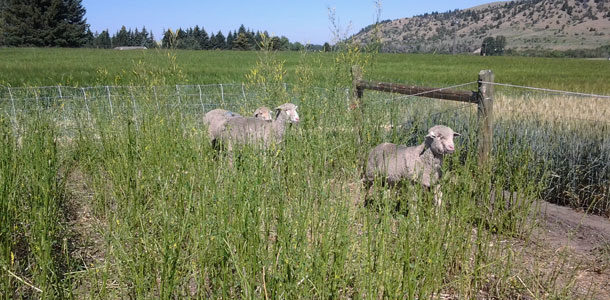Westbrook, 25, comes from a long tradition of sheep production. Her grandmother, 80, still operates the ranch, east of the Napa Valley – no vineyard, only sheep – which has been in the family for 123 years.
Her targeted sheep-grazing research is proposed as an alternative to conventional cover-crop management. The research is entering its final phase, but preliminary results indicate that using sheep to manage crop cover has several benefits – good daily weight gain for yearling lambs grazing on field peas and sweet clover, at the same time fertilizing the soil for planting of winter wheat.
Her second season of winter wheat went in the ground this week (Sept. 22) after her test plots at Montana State University’s Fort Ellis Research Center, just east of Bozeman, were grazed of their sweet clover cover this summer. Her 18 yearlings spent about 40 days grazing three test plots of clover (a biennial) planted last year. Her animals munched on field peas in the summer of 2013.
Her results show using sheep to manage the crop cover is better than tillage and equal to chemical terminations, she says, with the lambs exhibiting an average daily gain of .37 pounds on field peas. At the same time, the legumes were fixing nitrogen for the wheat.
"The winter wheat (planted last fall and harvested this summer) from the grazed plots showed no difference in yield from the chemically treated plots," she says. "The bushels-per-acre were comparable to chemical termination, and higher than tillage. The three test plots planted this fall will be harvested next August."
A cool, wet June this year delayed turning out of the lambs, but moved along well with the arrival of warmer weather in July and August.
Westbrook plans to eventually return to California and continue the family tradition of wool and lamb production. As for her grandmother, for whom she has the greatest respect, Westbrook says, "She is in charge."
The diminutive woman, "she stands five-foot nothing," is aided by a 12-year-old dog that watches for snakes and mountain lions, Westbrook relates with pride. The ranch runs 60 to 70 ewes with 10 to 12 replacements each year with lambing from January through April.
Westbrook has a double-major Bachelor of Science in rangeland resource science and cellular molecular biology from Humboldt State University where she was the top-range science graduate. Her attention to her studies garnered her a $5,000-per-year scholarship for five years from the California Farm Bureau Federation, "… without which I would not be here today," she notes.
She expects to receive her master’s degree in animal and range sciences in December, but says, "I would like to hang in the Bozeman area to see the finished work," i.e., the progress and harvest of the winter wheat in August 2015.
She is looking for a job that allows for her and her Great Pyrenees, Kahlan, to remain in the Gallatin Valley until the winter wheat comes into the lab for analysis. She is also looking to publish her master’s thesis – there are a couple of prospects, she says.
Jim Gransbery is the retired agricultural reporter at the Billings (Montana) Gazette.
PHOTO
Early research indicates grazing sheep on cover crops is superior to tillage or chemical applications on cover crops, and preps fields for fall planting. Photo provided by Jim Gransbery.










